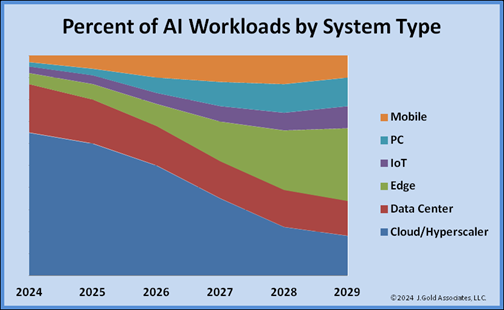- AI workloads will start to move to the edge, a new report suggests
- Cloud providers will still remain important in the handling of diverse workloads
- Industrial modernization with AI will happen but will move more slowly
Over the next five years, artificial intelligence (AI) workloads will start to shift from high-end large training systems run by cloud hyperscalers and in data centers to the network edge, using a manifold range of processors and systems, J.Gold Associates said.
“The potential for AI workloads is vast and will evolve from the current concentration of large models running in large data centers/cloud to a more distributed environment with a much greater range of AI compute requirements,” a recent report from J.Gold Associates said. “Over the next several years, the percentage of AI workloads will shift from primarily large training systems run on supercomputing chips, to a range of solutions running on diverse processors and system solutions.”

The analysts expect the “largest portion of all AI workloads to migrate to the Edge over the next few years” closer to the actual use cases that the AI software is being deployed for. This should improve the functionality, latency, privacy and security of such AI systems.
It will also stop the need to move large amounts of data to centralized computing platforms in the cloud or data center “which is expensive and impacts performance,” the report said. “Edge deployments will include running remote cloud instances on localized devices, so remote hyperscaler products should be well positioned for this migration,” J.Gold Associates noted.
This means that the cloud will remain important in the AI landscape, the report notes, even “as we move to inference based solutions across a wider array of system types,” with an increasing number of AI products offered by the major public cloud suppliers.
Personal devices will see an “AI explosion” the report said. J.Gold Associates expects AI-enabled PCs to grow to represent “85+% of the market within a few years” particularly among enterprise users. AI powered smartphones will dominate in the mid- to high-tier smartphone device market soon, with AI features trickling down over time.
Modernizing the industrial landscape with AI may take a little longer the report states.
The vast scope of the Internet of Things (IoT) encompassing everything from simple sensors to autonomous systems like robotics on the factory floor will require a wide range of AI systems the report said.
When it comes to updating 5G in factories, however, “these systems often roll out slowly due to infrastructure concerns and regulatory challenges, as well as a need to stay in-use for many years or even decades, often without the ability for upgrading,” the report states.